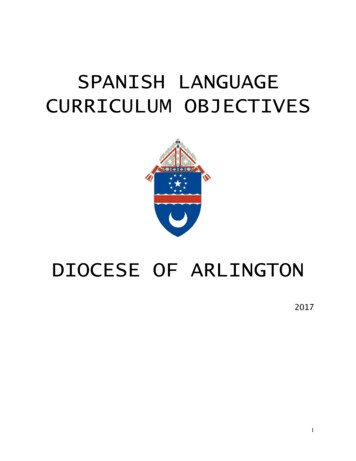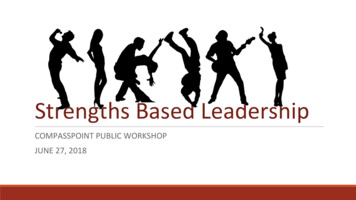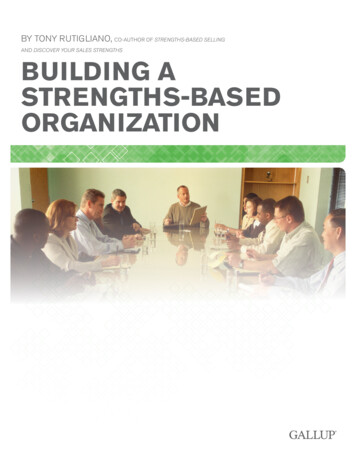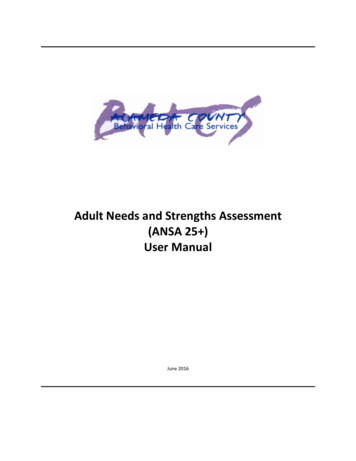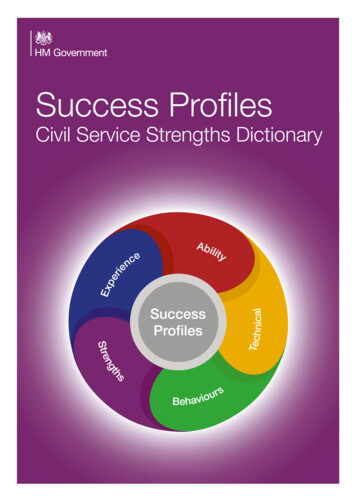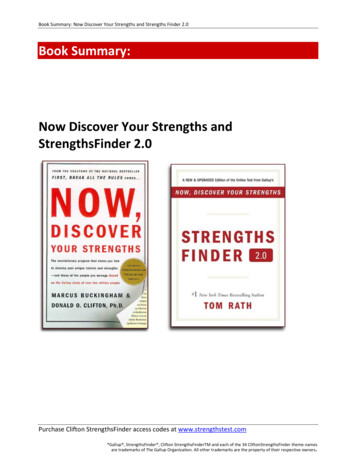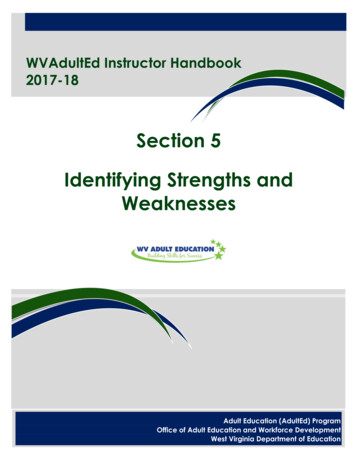
Transcription
WVAdultEd Instructor Handbook2017-18Section 5Identifying Strengths andWeaknessesAdult Education (AdultEd) ProgramOffice of Adult Education and Workforce DevelopmentWest Virginia Department of Education
The West Virginia Adult Education (WVAdultEd) Program is funded by the Adult Education andFamily Literacy Act, enacted August 7, 1998 as Title II of the Workforce Investment Act of 1998.WVAdultEd is administered through the West Virginia Department of Education Office of AdultEducation and Workforce Development, Building 6, Room 230, 1900 Kanawha Boulevard, East,Charleston, West Virginia 25305-0330.The WVAdultEd Instructor Handbook is produced by the WVAdultEd Professional DevelopmentProgram, whose fiscal agent is the Regional Education Service Agency (RESA) 3, 501 22nd Street,Dunbar, West Virginia 25064-1711.For questions or concerns related to the content of the WVAdultEd Instructor Handbook, contactCathy Shank at the WVAdultEd Hotline, 1-800-642-2670, or via email at cshank@k12.wv.us.RESA 3 does not discriminate on the basis of race, color, religion, sex, national origin, age, disability, or any othercharacteristic protected by law in access to, employment in, or provision of any of RESA 3’s programs, benefits, oractivities.
5Identifying Strengths and WeaknessesINTERVENTIONS REQUIRED BY THE WVADULTED PROGRAM . 1ASSESSING LEARNING STYLES2LEARNING STYLES VERSUS LEARNING DISABILITIES. 2LEARNING STYLES INSTRUMENTS . 2SCREENING FOR BARRIERS AND SPECIAL LEARNING NEEDS . 5RECOMMENDED SCREENING INSTRUMENTS . 5USING SCREENING INSTRUMENTS . 6IDENTIFYING RESOURCES AND ADDRESSING BARRIERS7ACCESSING COMMUNITY RESOURCES . 7ADDRESSING BARRIERS AND SPECIAL NEEDS . 8WEIGHTED ATTENDANCE/CONTACT HOURS FOR STUDENTS WITH DISABILITIES . 9MAKING REQUESTS FOR INFORMATION TO OBTAIN DOCUMENTATION FOR STUDENTS WITH DISABILITIES. 10MAKING REFERRALS FOR PSYCHOLOGICAL ASSESSMENT . 11APPENDIX13INTERVENTION INSTRUMENTS . 15C.I.T.E. LEARNING STYLES INSTRUMENT WORKSHEET . 17BACKGROUND ON THE CENTER FOR INNOVATIVE TEACHING EXPERIENCES (C.I.T.E.) LEARNING STYLESINSTRUMENT . 18C.I.T.E. LEARNING STYLES INSTRUMENT . 19DEFINITIONS AND TEACHING TECHNIQUES FOR LEARNING STYLES . 21LEARNING STYLE PREFERENCE FORM . 25LEARNING STYLE PREFERENCE SCORING FORM . 27LEARNING NEEDS SCREENING INSTRUMENT . 29LEARNING NEEDS SCREENING DIRECTIONS . 30LEARNING NEEDS SCREENING . 31PLAN FOR REDUCING BARRIERS TO SUCCESS . 37REQUEST AND REFERRAL FORMS . 39REQUEST FOR INFORMATION . 41SPECIAL LEARNING NEEDS REFERRAL. 42TESTING ACCOMMODATIONS ATTACHMENT . 44
This page intentionally left blank.
INTERVENTIONS REQUIRED BY THE WVADULTED PROGRAMIt is important to determine students’ strengths and weaknesses at the outset to help themknow what goals will be realistic and how to proceed with a plan of study. WVAdultEd programsare required to administer some type of screening instrument, questionnaire, and/or inventory(or a combination) to each student and to make interventions in the student learning planbased on the results. The intervention instrument(s) must include: Learning styles (auditory, visual, tactile, social, etc.) identification questions that willhelp you and your students identify materials and techniques that are best suited totheir strengths. Barrier identification questions (about problems with transportation, scheduling, childcare, health, family issues, etc.) that will help you assist the students in identifyingpotential problems and developing a plan to address these issues. Special learning needs screening questions that will tip you off to learning disabilities,attention deficits, and other special learning needs (e.g., vision or hearing problems,medical issues, etc.) so that you can identify appropriate strategies andaccommodations or make referrals for formal diagnoses.Different programs use different intervention instruments or combinations of instruments toscreen and follow-up on students.There are several instruments within this handbook that contain one or more of the requiredintervention instruments. These can be found in the Section 5 Appendix. SPOKES classes arerequired to use particular instruments (see Section 16).In addition to simply screening students, your program is required to follow-up by explainingthe screening results, developing individual strategies to address the problem areas, makingreferrals to outside agencies as needed, and documenting this process.Students with documented disabilities and other special needs should not be turned away. Onthe contrary, it is your job to find appropriate strategies and resources to assist them. Adultswho struggle to attend your program due to barriers in their lives need your assistance.WVAdultEd Instructor Handbook, Section 5, 2017-181
ASSESSING LEARNING STYLESAs adult educators, we need to become more aware of different modes of learning. Thetendency of most instructors is to deliver educational input in their own preferred style. Manytimes our students have had difficulty in the learning environment because they only receivedone type of input.Learners are often more successful when they receive input in their preferred learning style(visual, auditory, tactile, kinesthetic, etc.). It is important to help each learner become awareof his or her learning style and to provide appropriate input to enhance learning. Learnerswho are aware of how they best receive input can choose appropriate materials and settingsto work in as part of their plan of study. Instructors who pay attention to student learningstyles offer choices in how students receive input and demonstrate their learning.Learning Styles versus Learning DisabilitiesAll of us learn through our senses. We obtain information from a variety of modalities. Ourpreferred modalities are our learning styles. Some adults have impairments in one or more oftheir learning modalities caused by learning disabilities (LD).Adults with learning disabilities can ONLY receive information from their intact learningmodalities. Thus, for an adult with LD, his or her learning style is not simply a preference; it ismandatory. Adults with learning disabilities MUST receive information in particular ways, orthey cannot process the information and, therefore, cannot learn it.For example, adults with auditory processing disabilities have problems hearing andunderstanding oral instructions. They must have written instructions to know what to do. Incontrast, those with dyslexia may struggle with written text, but find the audio feature on somecomputer programs to be extremely helpful or even necessary.While discerning one’s learning style is valuable to almost any adult learner, it may be a vitalstep for an adult with learning disabilities. It may provide you with the key to how a particularlearner needs to receive and process information.Learning Styles InstrumentsA variety of instruments are available to help adult learners discover their preferred learningstyles. Find out if your local program requires that you use specific instruments and whichone(s). Because they may be freely reproduced, many WVAdultEd programs use the one ofthe following instruments: The C.I.T.E. (Section 5 Appendix) instrument distinguishes between learners whoprefer visual-language, visual-numerical, auditory-language, auditory-numerical,auditory-visual-kinesthetic, social-individual or social-group. SPOKES instructors arerequired to use the C.I.T.E.WVAdultEd Instructor Handbook, Section 5, 2017-182
Note: An Excel version that will automatically score the instrument is available fordownload at x . (Be sure to click onthe Summary tab at the bottom of the page to access the results worksheet.) The Learning Style Preference Form (Section 5 Appendix) from Linn-Benton CommunityCollege determines whether the student is a visual, auditory, tactile, or social learner. ESL instructors often use the pictorial ESL Learning Styles Questionnaire (Section 14).Many other inventories are available for purchase and some are available online free-ofcharge. A few of these are listed below: Human Relations Strategies for earninven.htmlThis is a short, 14-question survey designed to quickly assess learning styles. Index of Learning Styles es/ilsweb.htmlThis instrument is an online questionnaire designed to assess a person’s preferredlearning styles on four dimensions: active/reflective, sensing/intuitive, visual/verbal, andsequential/global. This inventory is free for the personal use of individuals and teacherswho want to use it with their students. Kiersey Temperament spx?partid 0The Kiersey Temperament Sorter is a 70-question personality instrument that helpsindividuals discover their personality type. You must register for an account to get amini-report. A full report is available for a fee. Learning Style .htm.This short, 24-question survey, developed by the University of Hawaii’s LearningAssistance Center, provides a quick and easy way to assess learning styles. This is a PDFdocument that is printable. For an online version of this assessment, visit Learning elder/public/Learning Styles.htmlThis webpage gives a list of resources by R. M. Felder relating to learning styles andlearning style models. Learning Styles Charthttp://www2.fiu.edu/ keysj/LearningStylesChart.pdfWVAdultEd Instructor Handbook, Section 5, 2017-183
This online chart gives learning style descriptions as well as strategies to enhancelearning for each of the following learning styles: visual, aural, reading/writing, andkinesthetic. It also gives a list of resources for each learning style that may be helpful forimproving one’s study skills. Learning Styles and Multiple .MI.htmThis site provides definitions and information relating to learning styles and MultipleIntelligence (MI). It also provides practical tips on how to use your learning styles toenhance your learning experience. You may take an online learning styles assessment.However, you must pay to see the results. Multiple Intelligences nt/findyourstrengths.htmlThis assessment will help you find out which intelligences are strongest for you.Teachers can use this with their students to find out which intelligences they use themost. This site also provides strategies for each of the different areas.WVAdultEd Instructor Handbook, Section 5, 2017-184
SCREENING FOR BARRIERS AND SPECIAL LEARNING NEEDSWhen adult learners decide to enter educational programs, they have many questions andconcerns. They want to know how adult education is different from their past educationalexperiences. They may have transportation, child care, or health-related problems to work out.They may have physical or learning disabilities that they are concerned about. They may havescheduling conflicts that will interfere with studies. Sometimes they are only beginning to thinkabout these barriers as they go through the registration process.Unless someone helps new students to pinpoint the problems and identify potential solutions,they may abandon the program before they ever get started.Recommended Screening InstrumentsAs you select and use screening instruments to identify barriers to attendance and speciallearning needs, it is important to remember that written instruments may need to be readaloud to students with low-level reading skills. Also, confidential information will need to behandled carefully (see Student Confidentiality in Section 4).All general adult education classes should use the Learning Needs Screening (Section 5Appendix) to help determine whether a student should be sent for formal diagnosis of adisability. The first part of the screening includes 13 questions that determine the need forreferral for formal psychological assessment. Other parts of the instrument screen for barriersto attendance and other special needs (vision, hearing, mental health, etc.). The AdditionalQuestions are related to barriers and job-related problems and the Confidential Questions(including the required three questions) relate to diagnosed conditions and medications usedby the individual. It is recommended that you complete the entire instrument regardless of thescoring on the first 13 questions. Finally, there is a follow-up form and release of information tohelp decide what referrals should be made and get permission to do that.SPOKES programs are required to use a special version of the Learning Needs Screening (seeSection 16 Appendix).ESOL programs may use the ESL Registration/Background Interview (see Section 14 Appendix)to identify special needs and barriers. It includes the three required questions.The WVAdultEd program requires that at a minimum all students must be screened forpotential learning difficulties with three questions: Have you ever had special help or special classes?Do you think you have trouble learning?What kinds of things do you have trouble with?)If students answer ‘yes,’ then appropriate investigation must occur to determine how best toserve the student in the program. It is not enough to ask the questions; instructors must followWVAdultEd Instructor Handbook, Section 5, 2017-185
up and determine how these issues will effect learning in the classroom. Referrals will still needto be made if a student indicates a barrier.Some programs have incorporated these three questions into their intake documents alongwith their own instruments for asking about barriers to attendance. However, the LearningNeeds Screening is the best instrument to assist in screening for barriers and special learningneeds and is preferred over simply using the three questions.Using Screening InstrumentsSimply administering a screening instrument to every student is not enough. Instructors mustuse the information to connect students to community resources and to adapt instruction tohelp students overcome barriers and learning difficulties.WVAdultEd Instructor Handbook, Section 5, 2017-186
IDENTIFYING RESOURCES AND ADDRESSING BARRIERSAfter screening is completed, discuss special needs as well as current and potential barrierswith the student. Make a plan together for how to address each issue.Accessing Community ResourcesThere are many community service organizations that can assist with a variety of needsincluding food, shelter, and transportation. Other agencies may help with documentingdisabilities, identifying accommodations, or providing educational services.You might be able to partner with your local Board of Education to transport adults along withtheir child to your class. You may be able to arrange for free glasses or hearing aids from thelocal Lions or Optimists Club.An adult with a disability (or likelihood of a disability) may need an official diagnosis from acertifying professional diagnostician in order to have access to the specific accommodationsneeded to be successful on assessments such as the high school equivalency assessment. Youmay need to refer the student to the Division of Rehabilitation Services (DRS) for diagnosis andjob assistance.A student with a disability or a special need may need to be scheduled to attend class at aspecific time when you can devote a little more time to providing assistance or you may need toarrange for one-on-one tutoring by contacting a Literacy WV program to obtain assistance froma volunteer.It is important to identify community resources to address barriers and special needs and set upassistance at the outset. To locate assistance in your community, there are several resourcesthat may be useful: Family Resource Networks (FRNs) in each county maintain lists of community resources.For a listing of West Virginia FRN locations and contact information, doc. Contact your local FRN to obtainthe local directory. Partners In Adult Education, Literacy, and Workforce Development In West Virginia(Section 1) includes descriptions and links for the following organizations with programsthat may be of assistance:o The Department of Health and Human Resources (DHHR) Bureau for Childrenand Familieso Literacy West Virginiao WorkForce West Virginiao West Virginia Division of Rehabilitative Services (DRS)WVAdultEd Instructor Handbook, Section 5, 2017-187
The WVAdultEd LiveBinder, located at https://www.tinyurl.com/wvabe, includes a tabfor Special Learning Needs (at http://www.livebinders.com/play/play/816321). Here youwill find links to resources in the following areas:ooooooooooooo Accommodations and Assistive TechnologyADHDChild Care ResourcesLearning DisabilitiesCollege ResourcesFamily Literacy ResourcesHealth Services ResourcesHearing ResourcesLegal InformationNational and State Hotline DirectoryRegional Family Resource NetworksUniversal DesignVision ResourcesAlthough it has not been updated recently, ConXtions is still a great resource in locatinglocal services. See sing Barriers and Special NeedsEarly identification of students with special needs is critical to developing an appropriateinstructional plan with needed classroom and testing accommodations. You should workcooperatively with your county school system, vocational rehabilitation programs, localpsychologists, and service agencies in developing a referral system for students who are likelyto have specific physical or learning disabilities or mental impairments.In addition, in order for students to show progress in a program, they need to attend class on aregular basis. If you can also deal with other barriers up front, you are more likely to retainstudents and truly meet the needs of the adults who come to you for help.As additional barriers or learning problems present themselves later on, encourage students tobe proactive and ask for support when it is necessary.There are several instruments to assist in addressing barriers and special needs: In the Section 5 Appendix, you will find the Plan for Reducing Barriers to Success. It canhelp you make plans to eliminate potential barriers and learning problems that you haveidentified and keep track of referrals you have made to appropriate agencies. For additional ideas, see Retention in Section 10.WVAdultEd Instructor Handbook, Section 5, 2017-188
Weighted Attendance/Contact Hours for Students with DisabilitiesIn recognition of the fact that adults with disabilities may require additional planning andinstructional time on the part of the instructor, WVAdultEd has a policy for weightedattendance/contact hours. For students with physical or learning disabilities or mentalimpairments that have a written diagnosis by a certifying professional, their attendance hoursare counted as “time and a half.” If the disability is visible (blind, missing limb, etc.), an officialdiagnosis is not necessary; but the instructor should make note of the disability in the student’sconfidential file.Examples of Disabilities Visual ImpairmentsHearing ImpairmentsSpeech ImpedimentsMobility ImpairmentsEmotional ImpairmentsPsychological ImpairmentsMental Impairment/RetardationDyslexia (reading disorder)Dysgraphia (writing disorder)Dyscalculia (math disorder)Attention Deficit Disorder (ADD)Attention Deficit HyperactivityDisorder (ADHD)DistractibilityClosed-head Injury Professionals Qualified to Document Disabilitiesor Mental Impairments Medical Doctors Rehabilitative Services Counselors University-based Clinic Staff Social Workers or Instructors who verifyexistence of documentation Clinical/Educational Psychologists Language Therapists Neuropsychologists and Neuropsychiatrists Neurologists School Psychologists/Psychometrists The professional must be familiar with thecandidate and be able to provide writtenverification that a physical or learning disabilityexists. The professional must have trainingappropriate to the diagnosis. School Record/IEPThe following procedures have been established to allow for weighted studentattendance/contact hours. Select Documented Disability as the student type on the Student Profile Form (Section 4Appendix) for students with a visible disability (blind, missing limb, etc.) or who presentdocumentation for any type of physical or mental impairment (including a learningdisability) that substantially limits or restricts one or more major life activities: walking,seeing, hearing, speaking, learning, or working. The instructor MUST maintain documentation from an appropriate certifyingprofessional in a separate confidential folder for each student meeting the criteria(unless the disability is visible, in which case it should simply be noted by the instructorin the confidential file).WVAdultEd Instructor Handbook, Section 5, 2017-189
In AEMIS, be sure that Documented Disability is selected as a student type. For everyhour logged on the Log Attendance Form for a student with a student type ofDocumented Disability, AEMIS automatically increases the hours on the 300A Form andClass Summary Report by an additional .5 hours in the appropriate FFL level. Because AEMIS handles this automatically, you should NOT input or record 1.5 hourswhen logging attendance within AEMIS; simply enter the actual time on task.Making Requests for Information to Obtain Documentation for Studentswith DisabilitiesIf an individual has been diagnosed with a disability or has a special education record, thatperson may already have documentation and may be able to demonstrate the need forclassroom or testing accommodations. Helping students obtain this documentation may savethem the expense of being reevaluated.These psychological assessments may also give you more information about the person’sstrengths and weaknesses and help you to decide what classroom and testing accommodationsshould be offered. The Americans with Disabilities Act (ADA) requires that those with a historyof being considered disabled must be offered appropriate accommodations.To request diagnostic information from schools or other agencies, use the Request forInformation Form (Section 5 Appendix).Once you obtain this documentation, the student will be eligible for weighted contact hours.Thus, it is beneficial to the program to obtain this documentation, maintain it in the confidentialfile, and select Documented Disability as a student type in AEMIS.This documentation may also allow the learner to request appropriate accommodations infuture educational, testing, and workplace settings whenever they are necessary. If anindividual is planning to take the TASC test, results from previous psychological evaluations maybe reinterpreted by a “certifying professional” or an “advocate” who can then fill out the TASCSpecial Testing Accommodations Request Form. For more information on TASC testaccommodations, see Section 12.Finally, the records may show that an individual was considered to have a “mental impairment”as opposed to a “learning disability.” It is important to note that older testing may not reflectaccurate diagnosis, when the diagnosis identifies “mental impairment,” “borderline” or “lowfunctioning.” A new assessment, due to better protocols and current knowledge, may provide alearning disability diagnosis.Requests for school records can be sent directly to the last school the individual attended, or inthe case of school closings or consolidation, to the county office. Use the Request forInformation (Section 5 Appendix) when requesting school records. It is important to note thateven though special education files are requested, sometimes only a transcript is sent. ThisWVAdultEd Instructor Handbook, Section 5, 2017-1810
does not mean that the student was never in special education classes. Special educationrecords are maintained separately from regular transcripts and the person who fills the requestfor transcripts may not be aware of records kept elsewhere. You may have to request recordsmore than once or send a follow-up letter clarifying what is needed.On occasion you may have students who attended special education classes but whose recordsare lost or unavailable. In other cases, students may have been in special education, but werenever diagnosed with a learning disability. If this happens it will be necessary to refer thestudent for a psychological assessment.Making Referrals for Psychological AssessmentAfter administering the Learning Needs Screening to an individual, if results indicate referral forfurther assessment is needed and no formal assessment has been done or no documentation ofa previous diagnosis is available, the individual should be referred to another agency for formalassessment to determine the nature of the problem.Referral to a Certifying Professional through the DRSIn many cases WVAdultEd students will qualify for assessment services through the Division ofRehabilitation Services (DRS). To qualify, a client must be seeking future employment or toimprove his or her capacity to obtain better employment. When making referrals, it isimportant to make it clear to the intake counselor that the individual’s lack of documentationprohibits the individual from accessing needed accommodations and thus poses a barrier tofurther training or career advancement.Referral Directly to a Professional DiagnosticianAdult students who are employed and have private insurance may want to be referred to aprivate “certifying professional.”What to Send to DRS or the Professional DiagnosticianPhotocopy or retype the Special Learning Needs Referral (Section 5 Appendix) onto yourprogram letterhead. Indicate the specific items that you are attaching to the referral: Provide as much class information as you have collected (assessment scores from TABE,Learning Needs Screening, notes of any difficulties you have observed, notes on anystrategies or accommodations you have used successfully, etc.). Provide copies of any old records you or the student can collect:oooo School records showing participation in special education servicesIndividualized Education Plans (IEPs)Transcripts from middle school or high schoolOther records showing a history of academic difficulties due to your disabilityHave the student sign the Release of Information to External Agencies (Section 4Appendix) listing the items the student permits you to send. Keep the original in theWVAdultEd Instructor Handbook, Section 5, 2017-1811
confidential file and send along a copy. Have the student sign a Request for Information (Section 5 Appendix) so that you canreceive the results of the formal assessment and discuss the case with the diagnosticianor counselor. Send the original to the diagnostician and keep a copy in the confidentialfile.If the individual is seeking the high school equivalency diploma, explain that the TASC SpecialTesting Accommodations Request Form will need to be completed by a professionaldiagnostician in order for the student to receive accommodations for any of the following: Attention Deficit Hyperactivity Disorder Emotional, Psychological, or Psychiatric Disorder Learning, Cognitive, or Intellectual Disability Physical Disability or Chronic Health DisabilityThe diagnostician will be a psychologist or doctor who administers a series of psychological,educational, or medical tests. This professional is likely to be unfamiliar with the process forobtaining TASC accommodations, so for individuals working toward a high school equivalencydiploma you will also need to send a number of attachments to help in completing the process: The Testing Accommodation Attachment (Section 5 Appendix) that indicates what youare sending and which accommodations you have used successfully
WVAdultEd Instructor Handbook, Section 5, 2017-18 1 INTERVENTIONS REQUIRED BY THE WVADULTED PROGRAM It is important to determine students’ strengths and weaknesses at the outset to help them know what goals will be realistic an



